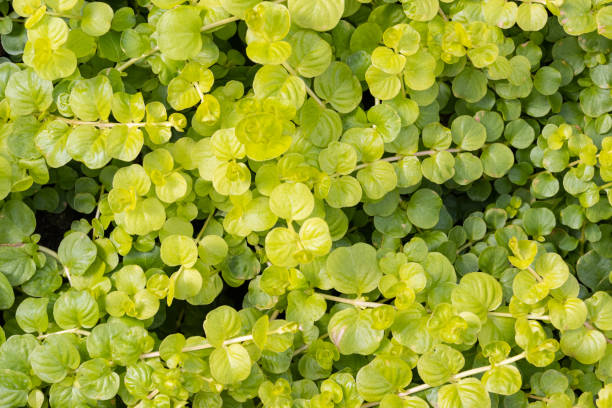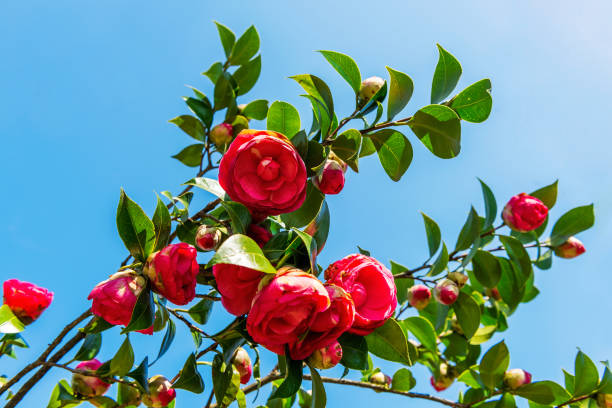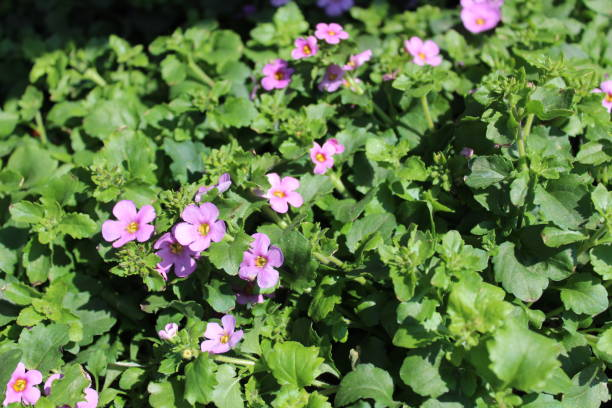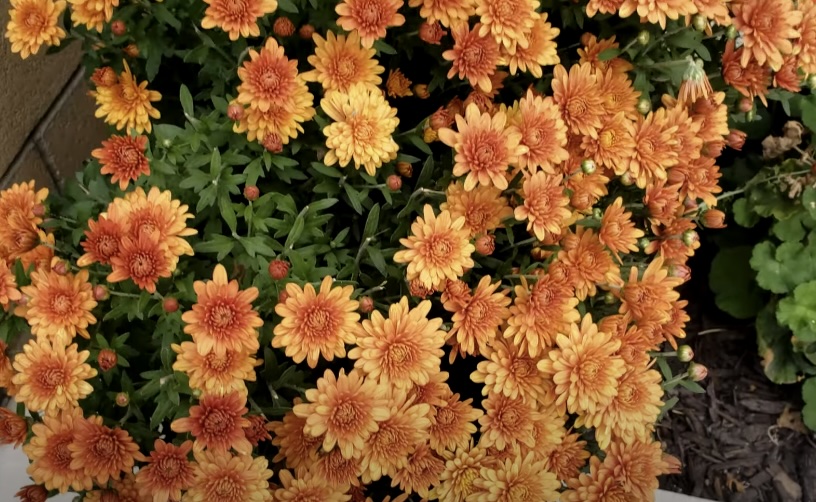Ground cover plants are an essential component of gardening in New Zealand. They not only enhance the visual appeal of your garden with lush foliage and vibrant blooms but also help in controlling soil erosion, suppressing weeds, and maintaining soil moisture. This article delves into the world of the best ground cover plants in NZ, providing valuable insights for both amateur and experienced gardeners.
1. Creeping Jenny (Lysimachia nummularia)
Scientifically known as Lysimachia nummularia, is a favored selection among the array of ground cover plants in New Zealand, esteemed for its lush green foliage adorned with striking gold accents. Its adaptability to varying light conditions, thriving equally well in both sunny and shaded areas, renders it a versatile choice for gardeners across different settings.
Features
Creeping Jenny exhibits several distinctive features that contribute to its popularity as a ground cover plant:
| Feature | Description |
| Growth | Displays fast-spreading tendencies, efficiently covering large expanses of ground in a short duration. |
| Flowering | Produces small, yet vibrant, bright yellow flowers that typically blossom during the early summer. |
| Ideal for | Excellently suited for various garden applications including borders, rock gardens, and hanging baskets. |
Care Tips
To ensure the thriving growth of Creeping Jenny, adhering to certain care guidelines is imperative:
- Soil: Optimal growth is achieved in soil that is both moist and well-drained. This facilitates proper root development and nutrient absorption, crucial for the plant’s health and vitality.
- Watering: Regular watering is essential, particularly during dry periods or when grown in containers. Adequate moisture levels sustain the plant’s lush appearance and prevent wilting or dehydration.
2. Blue Star Creeper (Isotoma fluviatilis)
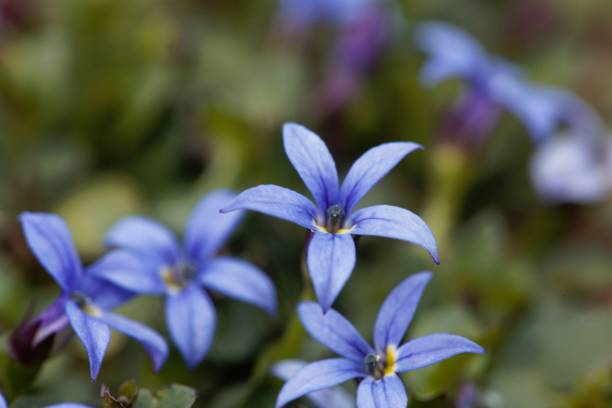
Blue Star Creeper, scientifically termed Isotoma fluviatilis, stands out as an exceptional addition to gardens in New Zealand, celebrated for its delicate blue flowers and dense foliage. This ground cover plant offers an array of features that make it a desirable choice for enhancing garden landscapes.
Features
Blue Star Creeper boasts several notable features that contribute to its popularity:
| Feature | Description |
| Growth | Exhibits a low-growing habit, forming a dense mat of foliage that carpets the ground effectively. |
| Flowering | Displays prolific blooming, adorned with star-shaped blue flowers that grace the plant during spring and summer. |
| Ideal for | Excellently suited for replacing lawns and filling the gaps between stepping stones, enhancing visual appeal. |
Care Tips
To ensure optimal growth and health of Blue Star Creeper, adhering to specific care practices is essential:
- Soil: While Blue Star Creeper can tolerate various soil types, it thrives best in well-drained soil conditions. Ensuring proper drainage facilitates healthy root development and prevents waterlogging, promoting overall vigor.
- Watering: This plant has moderate to high watering needs, especially during periods of active growth and in warmer weather. Consistent moisture levels are crucial for sustaining lush foliage and promoting continuous flowering.
3. New Zealand Brass Buttons (Leptinella squalida)
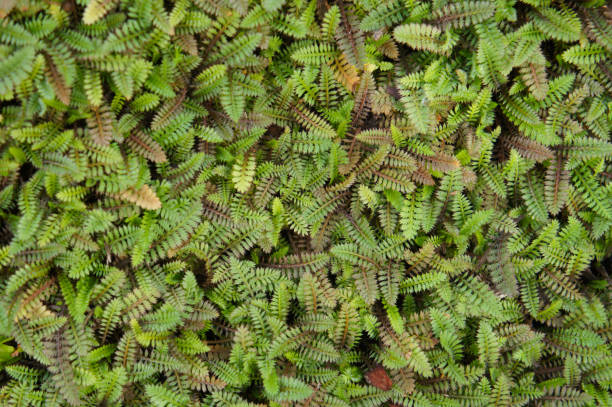
Originating from New Zealand, the New Zealand Brass Buttons, scientifically known as Leptinella squalida, stand out for their distinct feathery, fern-like foliage and diminutive button-like flowers. These unique characteristics make them a fascinating choice for gardeners looking to embellish their outdoor spaces with indigenous flora.
Features
New Zealand Brass Buttons possess several noteworthy features that contribute to their appeal:
| Feature | Description |
| Growth | Demonstrates rapid spreading tendencies, swiftly covering the ground to form a dense and compact ground cover. |
| Flowering | Exhibits small, yellowish-green flowers that emerge in spring, adding subtle charm to the plant’s appearance. |
| Ideal for | Excellently suited for filling gaps between pavers and adorning garden paths, enhancing aesthetic appeal. |
Care Tips
To ensure optimal growth and vitality of New Zealand Brass Buttons, adhering to specific care practices is crucial:
- Soil: These plants showcase versatility in their soil preferences, tolerating a wide range of soil types, including sandy and clay soils. However, ensuring adequate drainage is essential to prevent waterlogging and maintain plant health.
- Watering: New Zealand Brass Buttons have moderate watering needs. Providing consistent moisture, especially during dry spells, helps sustain vigorous growth and lush foliage, promoting overall plant well-being.
4. Kidney Weed (Dichondra repens)
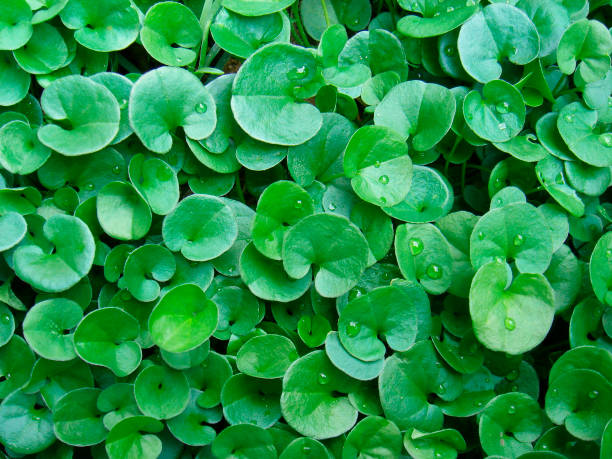
Kidney Weed, scientifically termed Dichondra repens, presents itself as another exemplary choice for ground cover in gardens across New Zealand, characterized by its rounded leaves and trailing growth habit. This plant offers a host of features that make it a desirable addition to outdoor landscapes.
Features
Kidney Weed boasts several distinctive features that contribute to its appeal:
| Feature | Description |
| Growth | Exhibits dense and lush growth, forming a thick carpet-like coverage on the ground. It can also climb when provided with suitable support structures. |
| Flowering | While it rarely flowers, Kidney Weed is primarily cultivated for its foliage, which serves as the focal point of its aesthetic charm. |
| Ideal for | Excellently suited for shade gardens and for underplanting beneath trees, providing verdant ground cover in areas with limited sunlight. |
Care Tips
To ensure the optimal growth and health of Kidney Weed, adhering to specific care guidelines is essential:
- Soil: Kidney Weed thrives in rich, well-drained soil conditions. Providing a nutrient-rich substrate with proper drainage facilitates robust growth and ensures the plant’s vitality.
- Watering: Consistent moisture is crucial for Kidney Weed’s well-being. Regular watering is necessary to maintain soil moisture levels, especially during dry periods or in locations exposed to direct sunlight.
5. Woolly Thyme (Thymus pseudolanuginosus)
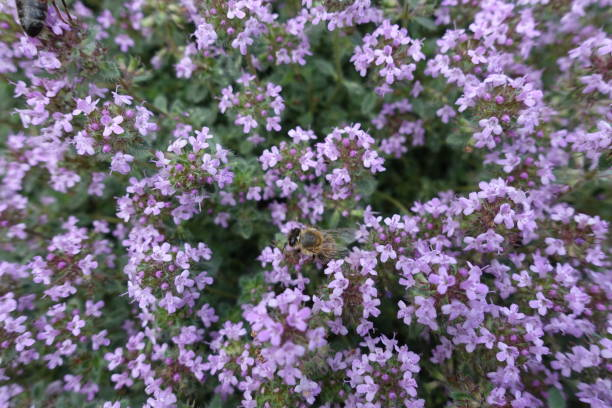
Woolly Thyme, scientifically referred to as Thymus pseudolanuginosus, is renowned for its velvety, soft foliage, making it a charming addition to any garden landscape. Its exceptional drought resistance and ornamental appeal render it a favored choice for gardeners seeking a resilient and visually appealing ground cover option.
Features
Woolly Thyme exhibits several distinctive features that contribute to its allure:
| Feature | Description |
| Growth | Characterized by its low and slow-spreading growth habit, Woolly Thyme forms a dense carpet close to the ground, gradually expanding over time. |
| Flowering | During the summer months, this plant adorns itself with delicate pink flowers, adding a splash of color to the landscape. |
| Ideal for | Excellently suited for rockeries, dry slopes, and as a substitute for traditional lawns, thriving in arid conditions and well-drained soils. |
Care Tips
To ensure the optimal growth and vigor of Woolly Thyme, adhering to specific care practices is essential:
- Soil: Woolly Thyme thrives in well-drained, gravelly soil conditions. Providing a substrate with excellent drainage facilitates healthy root development and prevents waterlogging, crucial for the plant’s overall well-being.
- Watering: Once established, Woolly Thyme exhibits low water requirements. While occasional watering may be necessary during prolonged dry spells, this plant is highly drought-resistant and can withstand periods of limited water availability without compromising its health or appearance.
6. Corsican Mint (Mentha requienii)
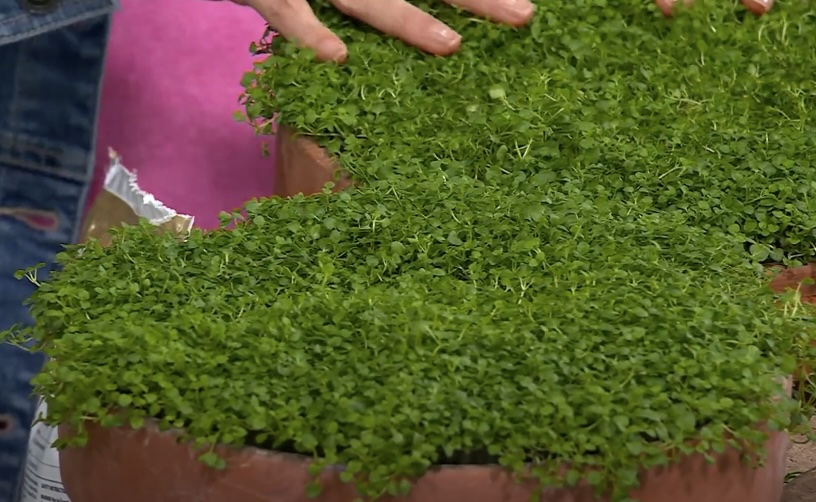
Corsican Mint, scientifically known as Mentha requienii, offers a delightful combination of visual charm and aromatic fragrance, making it a sought-after choice for gardeners seeking to enhance their outdoor spaces. This petite herbaceous plant boasts several features that contribute to its popularity as a ground cover option.
Features
Corsican Mint showcases several distinctive features that make it a desirable addition to garden landscapes:
| Feature | Description |
| Growth | Exhibits a creeping growth habit, forming a dense mat of foliage that can withstand light foot traffic without losing its lush appearance. |
| Flowering | Displays tiny, lilac-colored flowers during the mid-summer months, adding a subtle yet captivating touch of color to the landscape. |
| Ideal for | Excellently suited for pathways, between stones, or as an alternative to traditional lawns, enhancing visual appeal and fragrance. |
Care Tips
To ensure the optimal growth and vitality of Corsican Mint, adhering to specific care practices is essential:
- Soil: Corsican Mint prefers moist, well-drained soil conditions. Providing a substrate that retains moisture without becoming waterlogged promotes healthy root development and sustains lush foliage.
- Watering: Regular watering is crucial for Corsican Mint, particularly during hot and dry periods. Ensuring consistent soil moisture levels helps prevent wilting and maintains the plant’s vibrant appearance and aromatic fragrance.
7. Ajuga (Ajuga reptans)
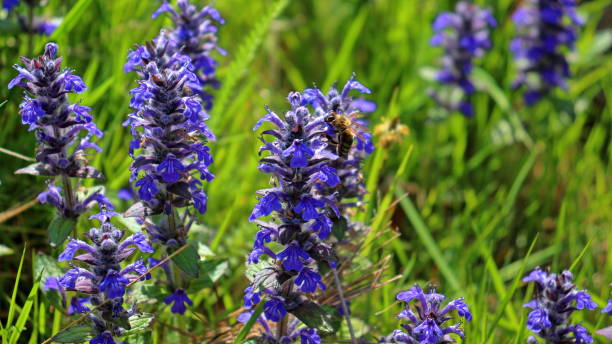
Ajuga, commonly referred to as bugleweed, stands out as a robust ground cover option admired for its vibrant foliage and charming spikes of blue flowers. This resilient plant offers an array of features that make it an excellent choice for enhancing garden landscapes.
Features
Ajuga exhibits several distinctive features that contribute to its popularity as a ground cover:
| Feature | Description |
| Growth | Characterized by its fast-growing nature, Ajuga spreads quickly through runners, efficiently covering large areas of ground in a relatively short period. |
| Flowering | During the spring and early summer months, Ajuga produces striking spikes of blue flowers, adding a burst of color to the landscape and attracting pollinators. |
| Ideal for | Excellently suited for covering expansive areas, thriving under trees, or embellishing shaded gardens with its lush foliage and vibrant blooms. |
Care Tips
To ensure the optimal growth and vigor of Ajuga, adhering to specific care practices is crucial:
- Soil: While Ajuga is tolerant of a wide range of soil types, it prefers moist, well-drained soil conditions. Providing a substrate with adequate moisture retention promotes healthy root development and sustains robust growth.
- Watering: Ajuga has moderate watering needs. Regular watering, particularly during dry spells or periods of prolonged heat, helps maintain soil moisture levels and supports continuous growth and flowering.
8. Sedum (Sedum species)
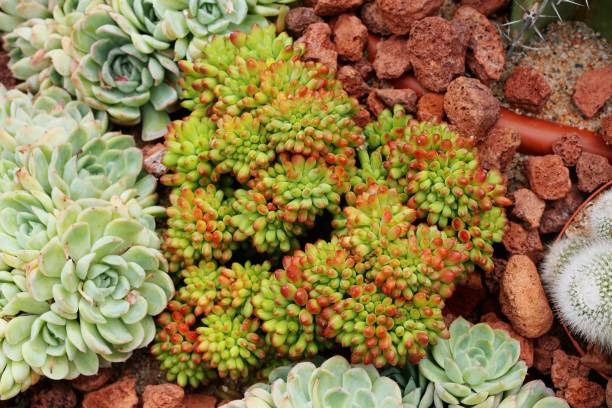
Sedums, commonly known as stonecrops, represent a versatile group of ground cover plants renowned for their adaptability to challenging conditions and the wide array of colors and textures they offer. These resilient plants are esteemed by gardeners for their ability to thrive in various environments while enhancing the aesthetic appeal of garden landscapes.
Features
Sedums exhibit several distinctive features that contribute to their popularity as ground cover options:
| Feature | Description |
| Growth | Characterized by succulent leaves that form dense, low mats, Sedums create visually appealing ground covers that are both drought-resistant and visually striking. |
| Flowering | During the late summer and fall months, Sedums produce star-shaped flowers in an array of colors including yellow, pink, or red, further enhancing their ornamental value. |
| Ideal for | Excellently suited for rock gardens, borders, and cascading over walls, Sedums add texture and color to various garden settings while thriving in tough conditions. |
Care Tips
To ensure the optimal growth and health of Sedums, adhering to specific care practices is essential:
- Soil: Sedums thrive in poor to moderately fertile, well-drained soil conditions. Providing a substrate with good drainage allows for proper root development and prevents waterlogging, crucial for the plant’s overall vigor.
- Watering: Once established, Sedums are highly drought-tolerant and require minimal watering. These resilient plants can withstand periods of limited water availability without compromising their health or appearance, making them an ideal choice for water-wise gardening practices.
Conclusion
Choosing the best ground cover plants in NZ can transform your garden into a vibrant, low-maintenance, and beautiful landscape. Whether you’re looking to enhance the aesthetics of your garden, control erosion, or suppress weeds, ground cover plants offer a practical and attractive solution. Explore these options to find the perfect plant that meets your gardening needs and conditions.
FAQ
Creeping Jenny is known for its rapid growth, making it one of the fastest-growing ground cover plants in NZ.
Yes, several ground cover plants like Kidney Weed and Creeping Jenny adapt well to shaded conditions, making them ideal for less sunny areas of your garden.
Regular maintenance, such as trimming and establishing clear boundaries, can control the spread of vigorous ground cover plants.
Woolly Thyme is highly recommended for its drought resistance, making it suitable for dry and rocky terrains.
